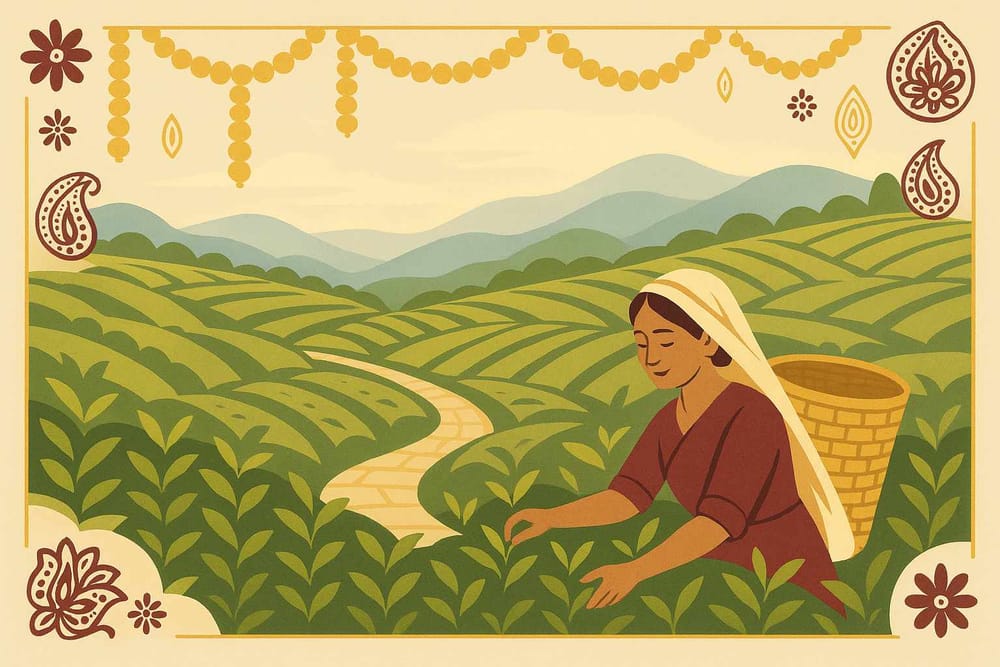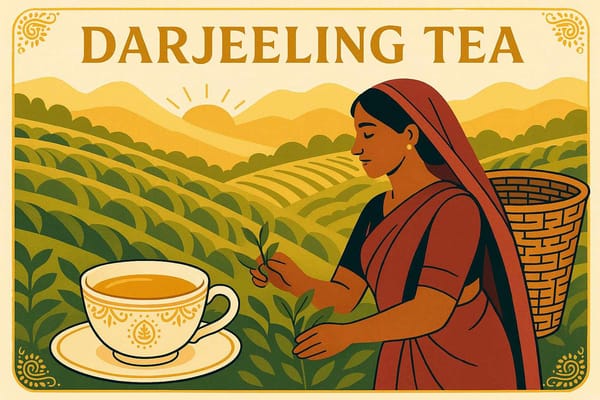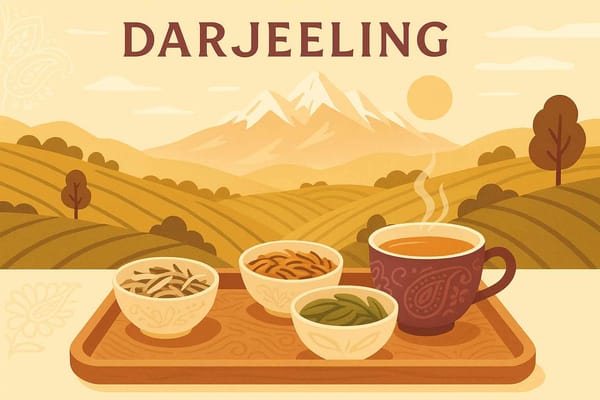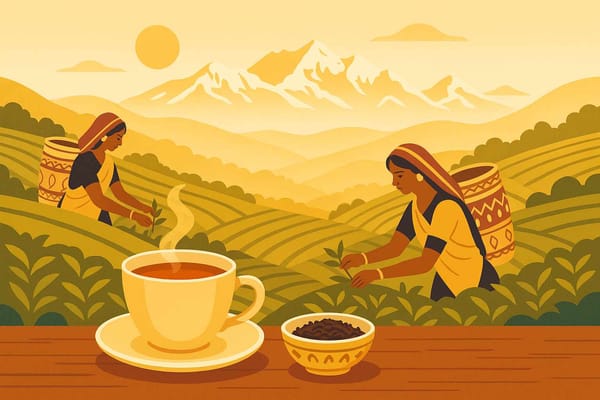
Explore Unique Flavors-Darjeeling Tea: A Journey Through Tea Gardens
Have you ever held a cup of chai that felt like it was whispering secrets of the mountains? For me, that magical experience is Darjeeling tea. It’s more than just a drink; it's a feeling, a warm hug on a misty morning, a story steeped in every leaf. It’s often called the "Champagne of Teas," and once you taste it, you understand why. It’s not just a fancy title; it’s a promise of elegance, a taste of a legacy that has been lovingly nurtured in the lap of the Himalayas.
Every time I brew a cup, its delicate aroma fills my home, and I am transported to the lush green slopes of West Bengal. Let’s take a journey together to understand what makes this brew so special, a true gift from nature and a testament to our rich heritage.
The Soul of the Soil: What Gives Darjeeling Tea Its Magic
In our culture, we believe that the land (dharti) has its own spirit, and it generously gives its essence to everything that grows on it. This is perfectly true for Darjeeling tea. The secret lies in its unique ‘terroir’ – a beautiful word that describes the complete natural environment, including the soil, the high altitude, the cool mountain air, and the gentle morning mist. It’s this specific combination that you can’t find anywhere else in the world.
- The Himalayan Advantage: The tea gardens are perched on steep, high-altitude slopes. This height means the tea plants grow slower, allowing them to develop a much deeper and more complex flavour. The natural drainage prevents water from collecting at the roots, ensuring the leaves have a crisp, delicate taste.
- A Symphony of Microclimates: What's fascinating is that no two tea estates in Darjeeling taste exactly the same! Each garden has its own little microclimate, its own unique personality, which is reflected in the final brew. This is why connoisseurs can often tell which estate a tea comes from, just by its aroma and taste.
A Season for Every Sip: The Rhythms of the Harvest
The magic of Darjeeling tea also lies in its timing. The leaves aren't just picked whenever; they are harvested in specific seasons, known as ‘flushes’. Each flush offers a completely different experience, a new story in your cup. It’s like celebrating different festivals throughout the year; each has its own flavour and emotion.
- First Flush (Spring’s First Whisper): Harvested from late March to April, these are the first tender leaves after the winter slumber. This tea is light, airy, and has a beautiful floral fragrance. It’s crisp and vibrant, like the feeling of the first warm day of spring. It's truly the most prized and delicate of them all.
- Second Flush (Summer’s Golden Embrace): Picked in June, this is when the tea develops its world-famous ‘muscatel’ flavour. Imagine a sweet, fruity note like that of muscat grapes, with a wonderfully rich and full-bodied taste. This is the classic Darjeeling character that has won hearts across the globe.
- Autumn Flush (The Comforting Warmth): As the year winds down, the autumn harvest around October and November gives us a tea that is smooth, mellow, and often has lovely nutty or woody notes. It’s the perfect comforting cup for a cool evening, with a rich copper colour that feels like the season itself.
The Human Touch: The Art of Crafting Perfection
The journey from a fresh leaf to the tea in your cup is a delicate art, passed down through generations. It’s a process filled with care and precision, where tradition meets expertise. After the pluckers, mostly women with skilled hands, carefully select only the top two leaves and a bud, the real craftsmanship begins.
The leaves are first withered to reduce moisture, then gently rolled to release their essential oils. This is followed by oxidation, a crucial step where the leaves react with the air to develop their characteristic flavour and colour. Finally, they are dried to lock in all that wonderful aroma and taste. It’s this meticulous process that ensures every sip is perfect.
Savoring the Perfect Cup at Home
To truly enjoy this Himalayan treasure, brewing it correctly is key. Always use fresh, clean water and bring it to a boil, then let it cool for a minute to about 80-90°C. Pour this water over the leaves and let them steep for 3-5 minutes. Over-brewing can make it bitter, so be mindful of the time. You’ll be rewarded with a cup that is not just refreshing but also filled with antioxidants that are good for your heart and soul. And yes, like most teas, it does contain a moderate amount of caffeine to give you a gentle lift.
This beautiful ritual of brewing and sipping Darjeeling tea is a small way to connect with a timeless tradition. Just as our rituals and stories connect us to our roots, a simple cup of tea can connect us to the majestic Himalayas.
At Bhaktilipi, we believe in celebrating these deep-rooted traditions that bring meaning and peace to our lives. We are a space dedicated to sharing the wisdom of our ancient devotional literature and practices in a way that resonates with today’s world. If the story of this divine tea inspires you, you'll find countless such treasures on Bhaktilipi.in, helping you stay connected to your spiritual side.
Follow our journey and get your daily dose of inspiration on Facebook, Instagram, and YouTube. Let’s explore our heritage together.
A passionate group of people dedicated to preserving India's knowledge of Dharma, Karma, and Bhakti for ourselves and the world 🙏.
Comments
Related in

The Rich Legacy and Unique Flavors of Darjeeling Tea - Explained
There’s something magical about a warm cup of tea, isn’t there? It’s more than just a drink. It’s a moment of peace, a comforting friend on a rainy afternoon, and a silent companion during late-night conversations. For me, and for many of us in India, that

The Unseen Varieties of Darjeeling Tea: White to Golden Tips Explained
Close your eyes for a moment. Can you feel the cool Himalayan mist on your skin? Can you smell that fresh, earthy scent after a light drizzle on the mountainside? That, my friend, is the very soul of Darjeeling, and it’s captured perfectly in a single cup of its

Exploring Darjeeling Tea-History and Flavors
Have you ever held a warm cup of tea, closed your eyes, and felt transported to another place? For me, a cup of authentic Darjeeling tea does just that. It’s not just a beverage; it's an experience. With every sip, you can almost feel the cool mist
